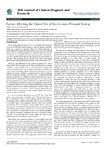Factors Affecting the Clinical Use of Non-Invasive Prenatal Testing
| dc.contributor.author | Skirton, H | |
| dc.contributor.author | Jackson, L | |
| dc.date.accessioned | 2016-08-04T12:45:43Z | |
| dc.date.available | 2016-08-04T12:45:43Z | |
| dc.date.issued | 2015-01-01 | |
| dc.identifier.issn | 2376-0311 | |
| dc.identifier.issn | 2376-0311 | |
| dc.identifier.uri | http://hdl.handle.net/10026.1/5182 | |
| dc.description.abstract |
Introduction. Non-invasive prenatal testing (NIPT) is a technique first developed in the early 1990’s that enables testing of a fetus for genetic conditions, based on a sample of maternal blood [1]. Small fragments of extracellular DNA from both mother and fetus are present in maternal plasma, and by excluding fragments of maternal origin, the fetus can be tested for sex, aneuploidy and some specific genetic conditions [2]. Нe main benefits of this type of fetal testing over amniocentesis or chorionic villus sampling are the removal of any risk of miscarriage due to invasive testing and obtaining results in the first trimester [2]. Нere are some diوٴerences in the contexts in which NIPT can be used to determine the chance of the fetus being affected by a genetic condition. In some families, there is a known genetic condition that could be inherited by the fetus. Examples of this type of condition are cystic fibrosis and achondroplasia. In these families, the genetic mutation is usually known of before pregnancy and the prospective parents may have been considering prenatal testing for some time. In a diوٴerent context, pregnant women may be offered NIPT for aneuploidy (including trisomy 21). All women in the general population have a chance of having a fetus affected by trisomy 21, and testing may therefore be offered on a population basis. Women in this group may not have ever considered fetal testing prior to being informed about it by the health professional involved in their care during pregnancy. Нe extent to which prenatal testing had been considered prior to pregnancy could seriously influence the level of informed consent for the test. | |
| dc.language.iso | en | |
| dc.publisher | OMICS Publishing Group | |
| dc.subject | Hematology | |
| dc.subject | Clinical Research | |
| dc.subject | Pediatric | |
| dc.subject | Genetics | |
| dc.subject | Genetic Testing | |
| dc.subject | 4.1 Discovery and preclinical testing of markers and technologies | |
| dc.subject | Reproductive health and childbirth | |
| dc.title | Factors Affecting the Clinical Use of Non-Invasive Prenatal Testing | |
| dc.type | journal-article | |
| plymouth.issue | 01 | |
| plymouth.volume | 03 | |
| plymouth.publication-status | Published online | |
| plymouth.journal | JBR Journal of Clinical Diagnosis and Research | |
| dc.identifier.doi | 10.4172/2376-0311.1000121 | |
| plymouth.organisational-group | /Plymouth | |
| plymouth.organisational-group | /Plymouth/Faculty of Health | |
| plymouth.organisational-group | /Plymouth/Faculty of Health/School of Nursing and Midwifery | |
| dcterms.dateAccepted | 2015-01-01 | |
| dc.rights.embargodate | 2023-10-11 | |
| dc.identifier.eissn | 2376-0311 | |
| dc.rights.embargoperiod | No embargo | |
| rioxxterms.versionofrecord | 10.4172/2376-0311.1000121 | |
| rioxxterms.licenseref.uri | http://www.rioxx.net/licenses/all-rights-reserved | |
| rioxxterms.type | Journal Article/Review |


